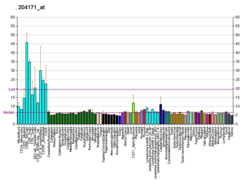This gene encodes a member of the S6K family of serine/threonine kinases, which phosphorylate several residues of the S6 ribosomal protein. The kinase activity of this protein leads to an increase in protein synthesis and cell proliferation. Amplification of the region of DNA encoding this gene and overexpression of this kinase are seen in some breast cancer cell lines. Alternate translational start sites have been described and alternate transcriptional splice variants have been observed but have not been thoroughly characterized.
mTOR
The p70S6 kinase is a downstream target of mTOR (mammalian target of rapamycin) signaling, specifically mTORC1, an mTOR-containing complex characterized by the inclusion of Raptor rather than Rictor (mTORC2). mTOR can be activated via an AND-gate-like mechanism at the lysosome, integrating signals about growth factors and bioavailability of important molecules. For instance, amino acids such as arginine and leucine can trigger lysosomal recruitment of mTORC1. Once at the lysosome, mTOR can be activated by Rheb, a small, lysosomal-resident GTPase, in its GTP-bound state. Rheb GTPase activity is stimulated (and therefore capacity to activate mTOR diminished) by the upstream TSC complex, which is inhibited by IGF signalling. Thus, the AND gate consists of proper localization by sufficiency of amino acids and activation by growth factors. Once mTOR has been properly localized and activated, it can phosphorylate downstream targets such as p70S6K, 4EBP, and ULK1 which are important for regulating protein anabolic/catabolic balance.
Physical exercise activates protein synthesis via phosphorylation (activation) of p70S6K in a pathway that is dependent on mTOR, specifically mTORC1. This has been demonstrated by using an inhibitor of mTOR, rapamycin, to block an increase in muscle mass, despite increases in load (e.g., exercise). Exercise has been shown to increase levels of IGF-1 in muscle, thus inducing the IGF-1/PI3K/Akt/p70S6K signaling pathway, and thereby increasing the protein synthesis that is required to build muscle.






